Annotation Culture on BookTok
can you highlight passages in a special edition? and other quandaries
Hi friends!
This week, we’re tackling a topic that’s been on my list since I started this newsletter: annotation. When I first got on BookTok, I couldn’t look away from the page flag speckled books, their edges festooned. How can people possibly be flagging that much? What are they getting out of this? Today we’re going on a journey of discovery at the intersection of reading, special editions, and arts and crafts.
Annotation happens across BookTok and Bookstagram (this is a crossover edition of Romancing the Phone), from romance to weird girl literature to literary fiction - it brings us together.
First, this guide to annotation, with millions of views, featuring that weird 2023 AI narration:
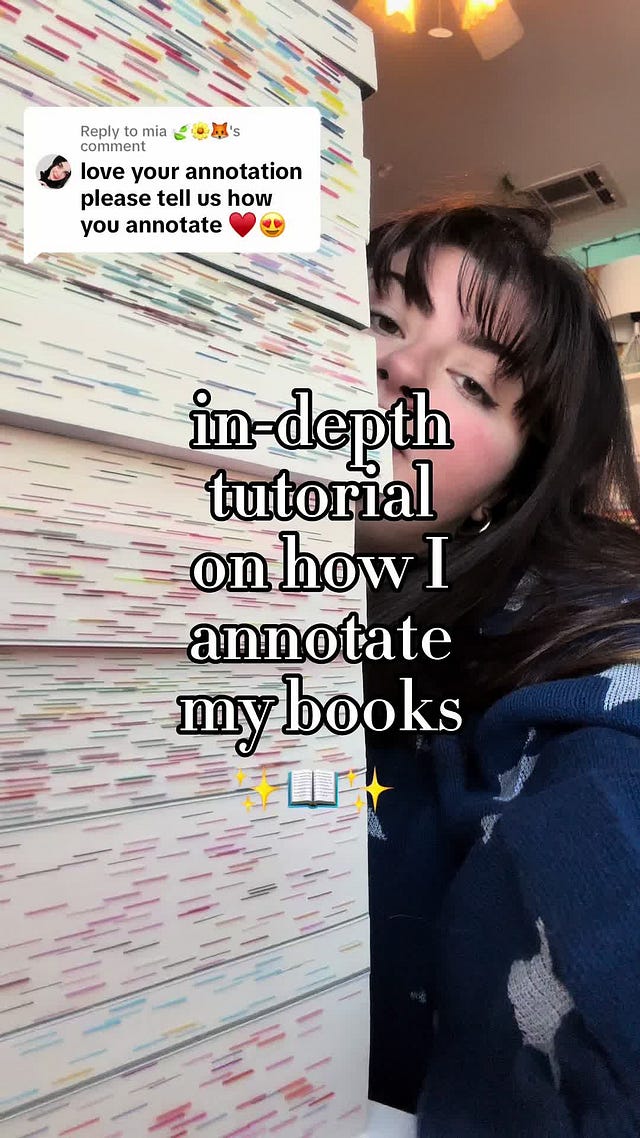
 Tiktok failed to load.
Tiktok failed to load.Enable 3rd party cookies or use another browser
I love that we start with a bookmark to use as a key to our annotation system here, and I am endlessly fascinated by the things people want to track. Here’s a list I’ve compiled after watching many many videos:
romantic scenes
romantic quotes
cute scenes
relatable quotes
sad scenes/quotes
extras
magic
funny
sad
love
angry
notes
setting and history
violence and themes
family
identity
faith
sacrifice
endurance
parts I love
sad parts
funny parts
shocking parts
romance
quotes I like
You get the picture. Some readers lean more academic, tracking themes and gender roles in The Handmaids Tale. And some annotate for personal pleasure, keeping track of the swooniest moments in their favorite romances.
A moment for literary BookTok:
Some take it seriously, and some doodle for fun:
(Substack/TikTok still won’t let me directly embed gallery posts (WHY) but I recommend clicking in and watching this one, it’s very funny)
This video, about low stakes annotation, coins some excellent new terms, namely: hot girl highlighters and hobbit mindset:
Which leads me to my first question: who was the first person who decided we needed to highlight all MMC dialogue in blue and all FMC dialogue in pink? Are readers doing this all the way through their books? Is there something soothing in the exercise, like a kind of literary paint by numbers? Maybe I need to try it. I love that people are personalizing their reading practice and proudly sharing their private rituals. All of this analog annotation is particularly interesting to me in a world where the kindle (and kobo, etc) has made digitally annotating a book and seeing everyone else’s favored passages so easy. In many annotation videos, readers even show themselves transferring their digitally highlited annotations into their physical books. I think this all gets at the rejuvenated importance of the paper book in online reader culture. Annotation and special editions and shelf trophies are, if you will forgive me, pages in the same book.
A step beyond annotation is the reading journal or reading scrapbook:
Obsessed with this, wow. I need to learn a new hobby (drawing) to get better at my hobby (reading).
Since BookTok is such a visual medium, I think we’ll see these artsy ways of reading continue to escalate. As we’ve previously discussed, character art is now a hugely important part of book promotion on (and off) social media, and these two practices feel connected. What’s next? Custom sticker sheets for readers who pre-order books from local indies so they can include them in their reading journals? (yes, obviously, someone needs to do that). As a treat for us all, here is Ali Hazelwood’s most recent character art print, for Problematic Summer Romance (NSFW if you need a warning):
Annotation culture has also crept in to the way creators and writers share and promote books on Bookstagram and BookTok:
These kinds of videos and posts are everywhere, whether digitally created or analog:

 Tiktok failed to load.
Tiktok failed to load.Enable 3rd party cookies or use another browser
I love this sweet video, about friends annotating a copy of their friend’s favorite book for her birthday. Annotation as love language, as act of service - annotation as a way to make the act of sharing books even more meaningful (if you trust you get your books back).
She also touches on the anger and fear that crops up sometimes in the comments of these videos:
So many of us are taught from a young age that writing in books is bad, that dog earring pages is bad, that books are sacred objects to be treated only with reverence. But here’s a funny thing: I’ve had a series of wacky jobs, one of which was at a prominent archive and museum. And one of the things I learned was that scholars and curators really value copies of old, rare books that have been annotated. Why? Contemporaneous annotation gives us insight into how books were received at the time. It makes them feel more human. And they’re pretty rare.
So next time you cringe seeing an annotated book, you can reframe your perspective a little bit. OR you can follow this process for annotating a book without writing directly in it:
 Tiktok failed to load.
Tiktok failed to load.Enable 3rd party cookies or use another browser
All of this culminates with an incredible video I was sent by my friend Kaeley on Wednesday morning (shout out to Kaeley, a romance junkie and book conservator who is almost always the first person to read this newsletter and offer feedback every week). This astonishing piece of media, created by Jimmy Johns, proves that annotation and BookTok culture has crossed into the mainstream in ways I never imagined. I present you with a sexy passage about oregano presented and highlighted in true BookTok style:
In the immortal words of commenter @888.jazzyy:
Other news and notes
I finished Shield of Sparrows and have now completed the BookTok assignment for the month (Shield of Sparrows and Silver Elite). I enjoyed Shield of Sparrows but found it to be very slow going in the beginning. I didn’t get fully invested in the characters or the story until 60 or 70% of the way through the book, but I was LOCKED IN for the last 30% and I will definitely be reading the sequel. Warning, this one is a slow, slow burn, it takes them hundreds of pages to even hold hands. It was in some ways quite a conventional romantasy narrative, but I enjoyed the addition of monsters.
And just a quick trend report - seeing a lot of “books I read in 24 hours or less” posts this week:
The people want to binge. Relatable! Especially when the big romantasy books are slow and 700 pages long.
This week, I devoured the new Carley Fortune book, One Golden Summer. I laughed, I cried, I swooned, I wanted to move to Canada and live in a lake house. She just keeps getting better and better. Next week, I’ll be dropping everything to read Problematic Summer Romance. And the week after that, I’ll be in New York for the US Book Show, where I’ll be moderating a panel on BookTok (!!). If you’re in the city, email me and maybe we can grab a drink?
And one final lol:
xoxo


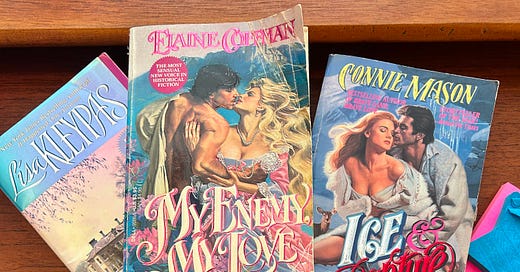



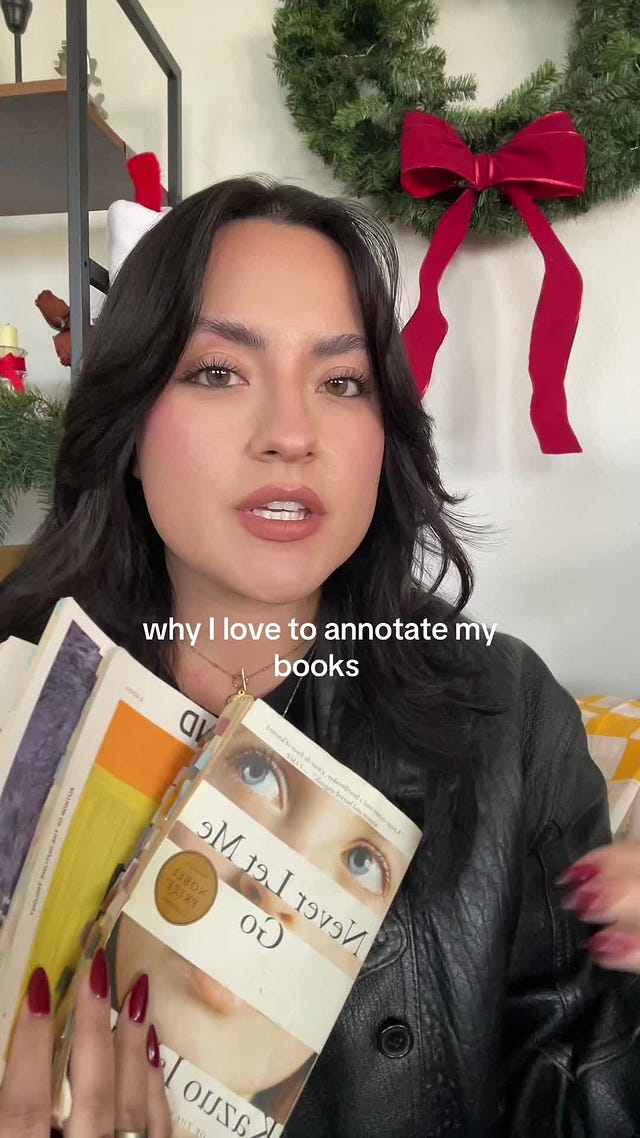

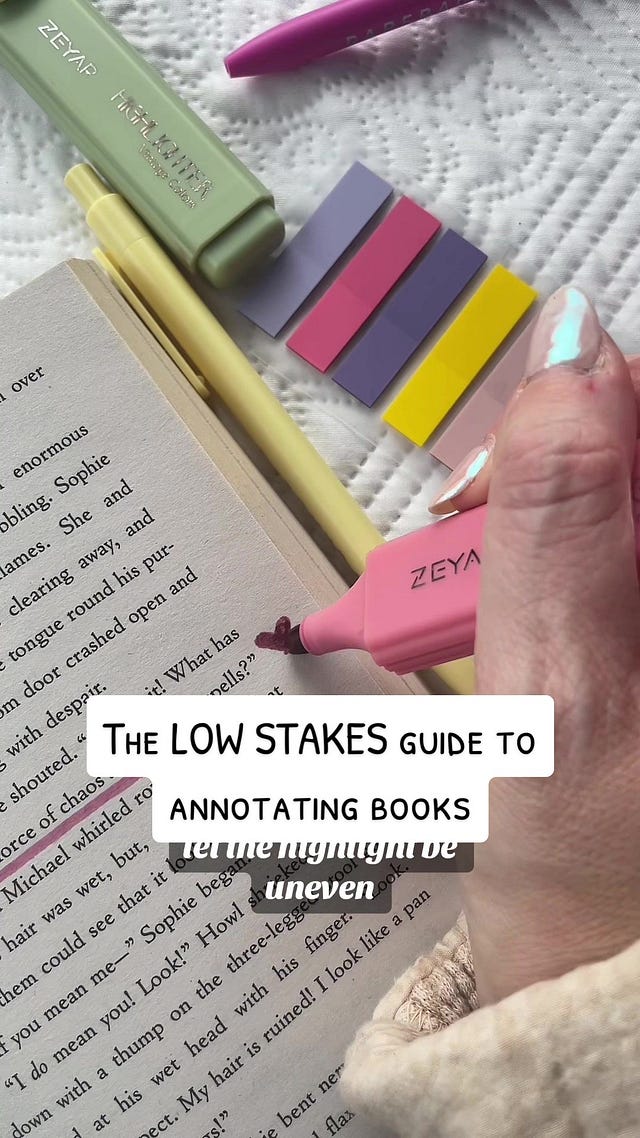
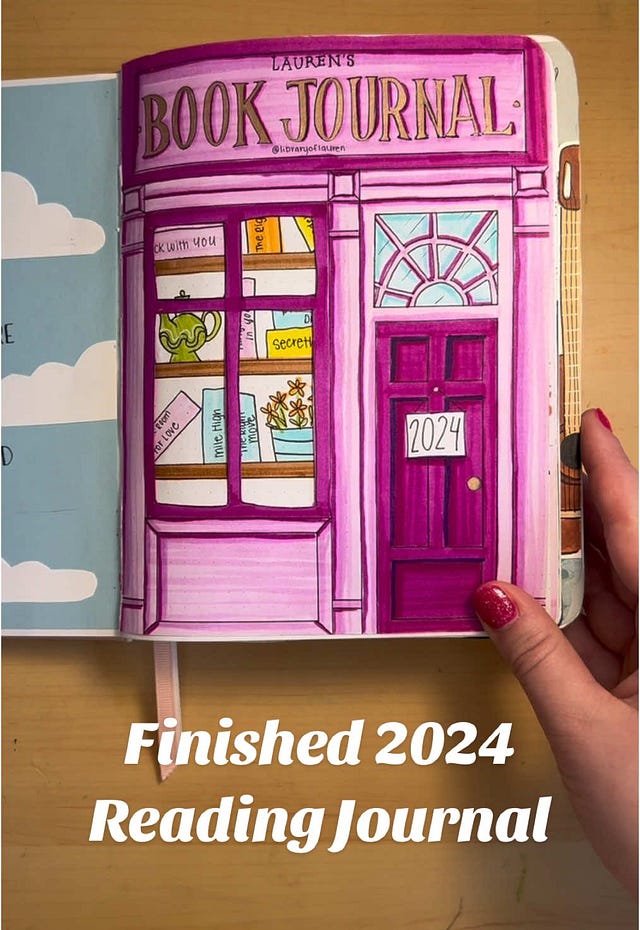
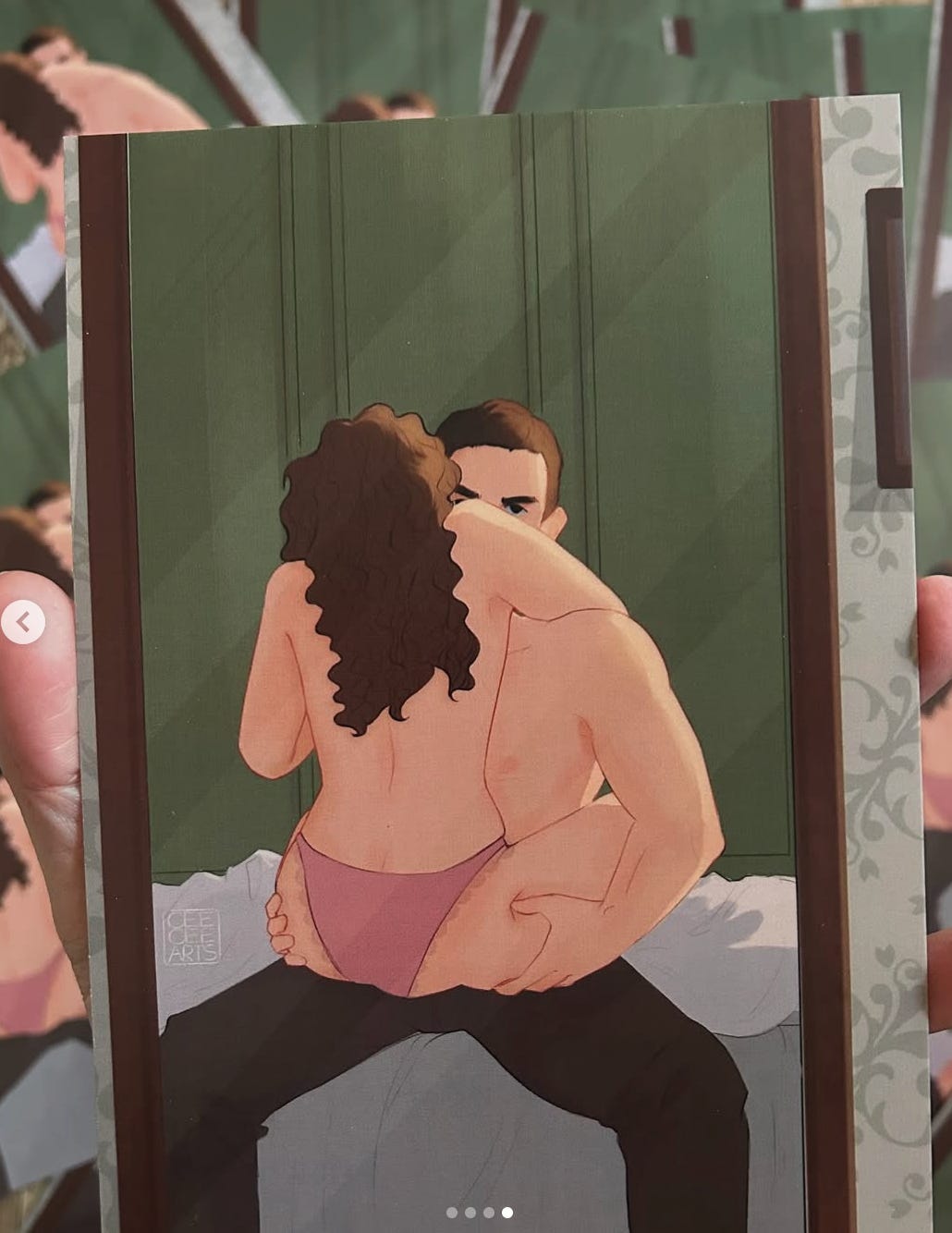
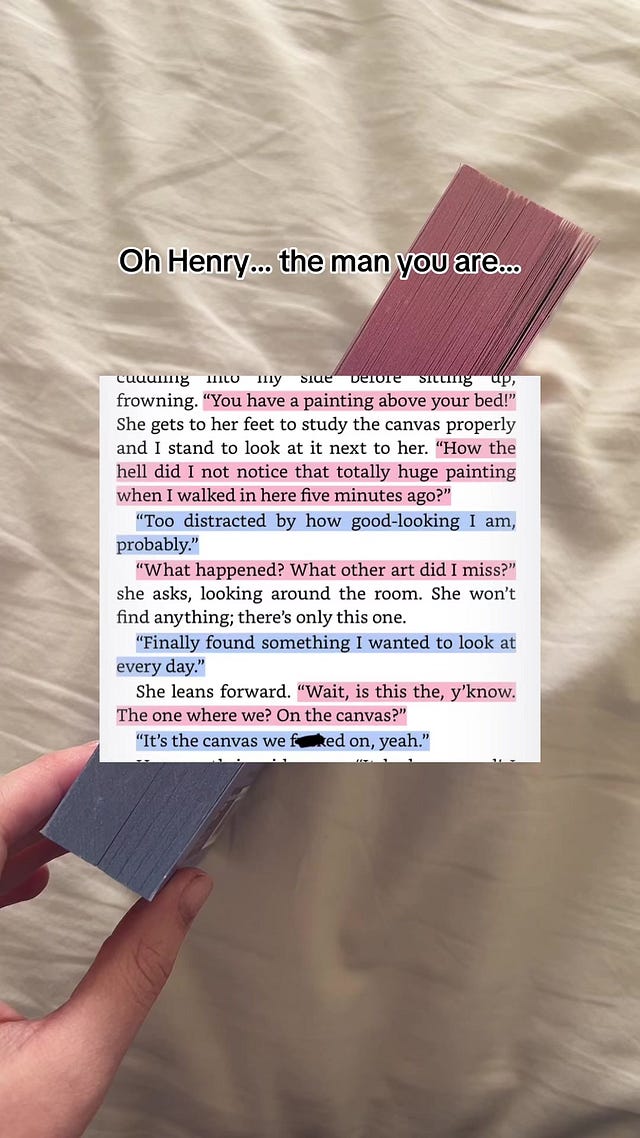





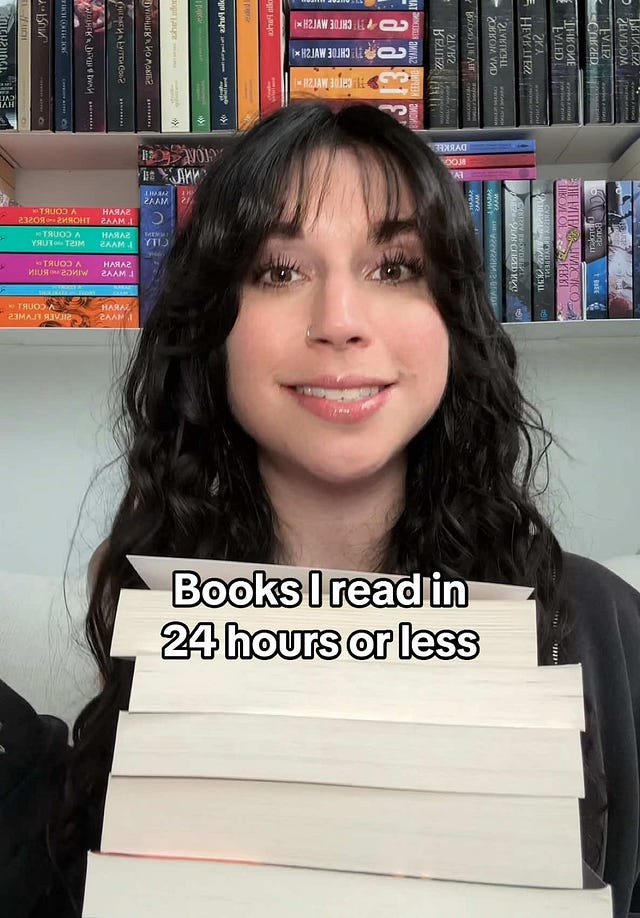
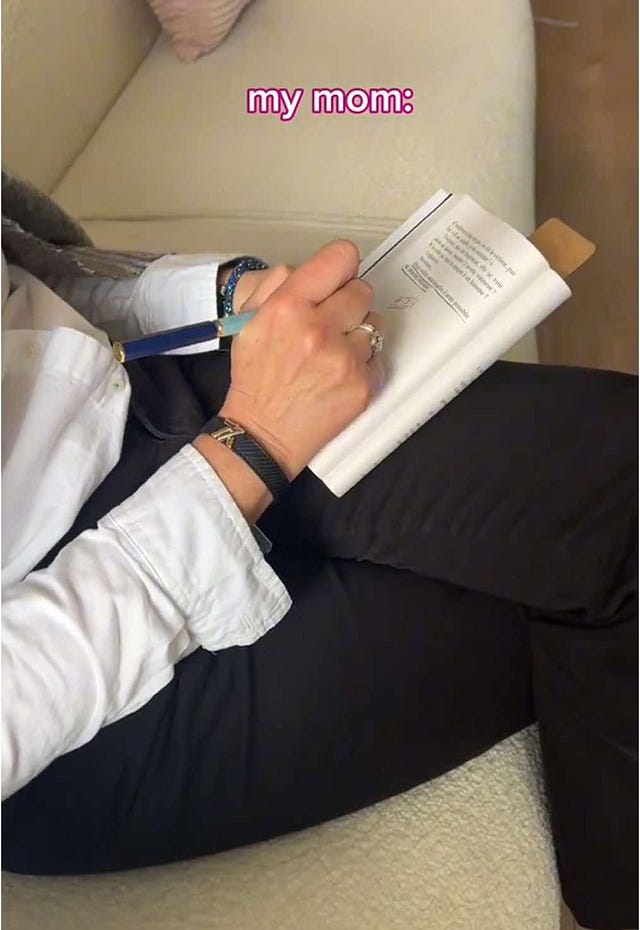
This might be my favorite issue of Romancing the Phone! I've always believed that annotation is an act of love. My mother and her two sisters use to write notes in the margins of novels that they shared. One of my favorite things about used books is thinking about the passages that previous readers underlined. In the books that I keep around for a long time, finding old notes is like finding a letter to myself. Just recently I found an old Bible on my shelves where my adolescent self had crossed out a passage where the Apostle Paul was explaining that women weren't supposed to preach. I wrote in the margin in purple ink: "Nope!"
Long-time annotator here (as username suggests).
I did my senior project in college on marginalia on manuscripts and early-printed books and studied book history in graduate school. Book historians LOVE annotations. We want to know what contemporary readers are thinking, or anyone who is coming to a text. Books are made to be read, used to death. These objects have their own life and that can inform literary studies alongside the text itself.
I have my mom's Riverside Shakespeare and it has all of her thoughts from her high school and college self. Sometimes in different copies of the same book we've made similar notes.
I also value my annotations more when I reread a text, usually will annotate in a different color pen.
(Generally, if I buy a book that is older than I am (not the text, but the copy itself), I don't annotate, especially not pen).